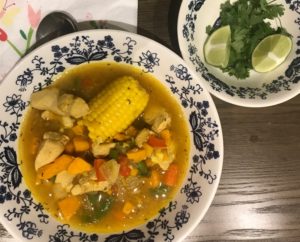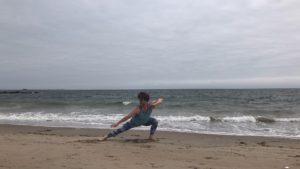
Now this little Niyama has gotten the short end of the stick because most yoga teachers I know are afraid to even reference God in classes, in short because of religious persecution, genocide, violent crusades, colonialism, cults, and pyramid evangelical schemes, but at least from a historical and anthropological perspective it pays to translate this one the right way.
Typically yoga teachers re-define this Yama to be open, humble, gracious, respectful, or simply to surrender, which are wonderful ideas, but that is wrong.
It literally means to devote or commitment yourself to the Lord, or to God. So you can see what kind of mess we are going to get into here, with many of our students perhaps atheist, or recovering Catholics, the mere mentioning of the word God makes some of us sick.
I feel that this Niyama needs to come back one way or another and not just on our yoga mats but as global citizens of Earth. One way we can still convey the power of this part of Patanajlis sutras is through the lens of Samkhya Philosophy which is rooted in not the belief of God, but the belief of the Purusha which is a theistic term that basically means “pure-consciousness”.
In just two short years, I will be celebrating 20 years of teaching yoga, and over 30 years of practice. There is a lot that I have seen in this small window of time and one topic that I really want to write about. When I finish teaching a class, I stay on my mat for a while just in case anyone wants to come up and ask me a question. I also continue to observe my students transition from Shavasana to sitting to chanting OM and closing the class with their intention. And there are basically two types of basic responses, one response is to immediately pop up, roll up the mat, and proceed to the next item on the agenda. The other basic type of response is to be more still and contemplative, perhaps taking more time to meditate, usually very quiet, and then gradually become more animated, and maybe start talking slowly and softly and perhaps socialize with the fellow classmates that may still be present, until they finally morph back into their “normal” self.
Now I know that the reality of life with time schedules may prohibit someone from the luxury of savoring that shavasana experience and the desire to linger or hang around in the studio for those few extra minutes after class, but I have been wondering about the students who seem to be following along, yet they may not be dropping in as deep. In fact though my observation I have keenly witnessed the difference between those that show up and put themselves through the poses, and those that drop into states of transformative soul-drenched embodiment.
When I first did my training at Sonic Yoga it was the year 2004, and I was in extremely good physical shape from my dance training and career. I put my whole body and soul into every breath, every vinyasa, and every assignment. I dreamt of teaching Surya Namaskar and offering assists, I had flash cards and memorized the Sanskrit for every asana, even though it wasn’t a requirement and I did all of this in part because I was really committed to yoga and wanted to dive in as deeply as I could, but also Lauren Hanna told us on the first day of the training,
“The more you put into this training, the more you will get out.”
She also romantically described how the way the breath or the prana really moves the body and that being a student of yoga is so much about the attention and devotion we have to our breath, which is the prana and the life force, and that each breath really leads the way to the next wave, until we find ourselves in this beautiful place of transcendence.
So, when I see the influencers on Instagram, and the tutorials and videos on instagram, I am always supportive of any teaching that comes from a genuine place of respect and love for yoga, but what I see appears to be mostly younger crowd, obsessed with their bodies and followers, obsessed with travel and teaching at huge international yoga conferences and festivals where they aren’t really teaching any alignment, they are just calling out the poses.
Calling of the name of a pose without offering breath que or alignment instructions isn’t really teaching yoga, its leading yoga, and almost anyone with familiarity of the asanas can do it. Add to the insult the onslaught of marketing giants stimulates the sympathetic nervous systems and acts as a buffer to actually keep the meditative state of mind at bay.
The fitness industry is a huge threat to the preservation of the ancient tenets of yoga that are time tested and true. How can we teach yoga that is less about the physical body and more about the inner or somatic state? And how can we convey this without the dogma or preachiness?
The reality is we all need to be mindful of our physical bodies, and the advanced poses that can be achieved through years of hard work and dedication. But if the nervous system never crosses over into the parasympathetic, and we are popping up after those 5 minutes in Shavasana, then are we really getting that deep connection and deep healing that is waiting for us if we just trust the flow and let go?
Yoga was such an important part of my life that I gave it the most attention and energy that I could possible give, and when I practiced I gave it my all and more. Often I was unable to move after class or even get up to chant OM, my body was relaxed I usually needed more time to transition, and feeling the deep healing current of shavasana was something that I never wanted to leave.
I know that we can never really gain a clear perspective of someone else’s practice because we can’t be in their body, but I do wonder about the students who after many years of practice, still haven’t learned to move with their breath. They still don’t know how to gaze at their drishti, and after years of training, they still appear to be awkward in their embodiment.
When I teach something, it’s always coming from a particular point of view where I have an invested interest and curiosity so that I can engage with the work, keeping my own energy receptive enough to be guided by the prana and to listen to the cells, to engage with the gross and subtle needs of my community. In this way I can take care of my own needs without being the teacher who needs to perform, to entertain, or to produce what the student thinks they need (handstand drills, tips to stretch the hamstring more, etc) and guide them to find what they ultimately need which is connection and love to the Source. If you dedicate your practice back to the Source or back to the well-spring of Pure-Consciousness or the Universe, or God, your practice is not going to feel typical, or surface-layer, but deep and penetrating right to your very essence.
And while our freedom and democracy erodes, it’s critical to dedicate our practice to the yamas and niyamas that most of our congress people and political leaders sold out to satisfy their own ego-centric political goals, and individual needs based on greed and power. At least we can keep our individual integrity while the masses lose their sanity.
*****

(vegetarians and vegans can substitute soy)
Ingredients
French Butter with sea salt, or vegetable oil of your choice
Fresh Cilantro
Black pepper
3 ears of fresh corn, peeled, husked and broken into thirds.
2 sweet onions, peeled and chopped
2 tsp ground dry turmeric
2 tsp ground dry ginger
1 tsp ground dry coriander
2 fresh limes
1 cup fresh grated ginger
1 pound fresh organic chicken breast, or vegetarian/vegan substitute.
vegetable or chicken stock
1 red pepper
1 cup carrots, peeled and chopped to bite size
1 cup sweet potatoes, peeled and chopped to bite size
1 cup chopped green beans, peeled and chopped to bite size
Optional White or Brown rice
In a skillet, heat up some butter or vegans could use sesame or coconut oil and brown the onions, and then towards the end add the dry spices, ginger, turmeric, and coriander.
In a separate soup pot slowly start to boil the carrots and sweet potatoes in the stock.
Bring to boil and let simmer.
Toss the onions and the spice mix in the soup pot.
Rinse off the chicken and cut it into bite size chunks with a scissors, and add some sesame oil to the pan that had the onions and spices, brown and cook the chicken and add it to the soup, adding the red bell pepper and green beans last.
Turn down the burner and slow cook until it’s yummy making sure the veggies are the right softness and chicken is cooked.
When the burning is off, add as much fresh ginger as you can stand.
Add black pepper, fresh cilantro and fresh lime juice to taste.
Enjoy!
The place down the street makes this amazing chicken soup and this is my take on it,
The fresh ginger, lime, and cilantro make this dish exceptionally refreshing, and more nutritional than your regular chicken noodle, try to use organic and local whenever possible.
******
THE CREATIVE PROCESS (from the movie, The Secret)
- Ask for what you want.
- Believe.
- Receive (as if you already have it)
You don’t need to know how you’re going to get what you want.
Anyone that ever accomplished anything, they didn’t know how they were going to do it.
You don’t need to know how, it will be shown to you.
Recognize doubt and replace it with unwavering faith.
You have to feel it because this is a feeling Universe.
You have to be clear with the universe about what you want to create, like when you order something at a restaurant, you get what you order, so be specific.
The law of attraction works
We attract whatever we are thinking
Our thinking and our thoughts create reality
You can start with nothing and no way and you can find a way.
It’s like a headlight in a fog – you only need to see right in front of you to go forward
You don’t have to see the whole road.
“Take the first step in faith. You don’t have to see the whole staircase just take the first step”
MLK
******
PRANA FLOW VARIATION SEQUENCE INTO RASA EKA PADA RAJA KAPOTASANA 1 AND VASITHASANA

Svadhistana Chakra Mandala Namaskar
Anahata standing and kneeling
Bhumi Vinyasa with Progression
1.Add lunge w prana mudra arms
2.Add Sahaja bhujangasaa
3.Add Sahaja shalabhasana
4.Adho Moksha Svanadana
Core plank knee to naval radiate one leg plank
DD lift leg
Hip joint mandala
Lunge PV
Vira 2
BV
Parsva Vira
1/2 triangle RV
1/2 MOON
1/2 split
Eka pada Raja Kapotasana to Parsva Vasithasana
Basic Kramas to explore up to the peak:
K1 tidal wave arms
K2 Plank tidal wave alternate (flowing vasithasana)
K3 side plank BV same arm
K4 Vasithasana Or Parsva Vasithasana


